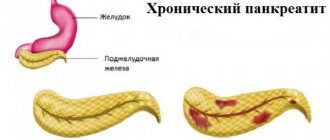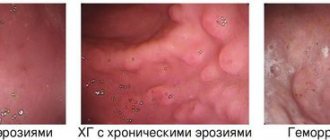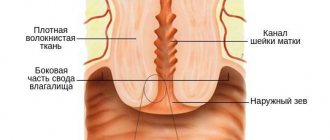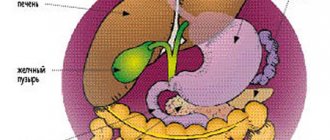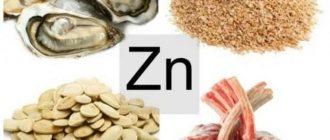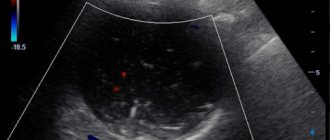Chronic pancreatitis (CP) is a long-term inflammatory disease of the pancreas, with manifestations in the form of irreversible changes in the structure of the organ, which cause pain and/or a persistent decrease in its function.
The pancreas performs important functions:
- secretion of most digestive enzymes
- production of insulin (a hormone whose deficiency develops diabetes mellitus)
There is a worldwide trend toward an increase in the incidence of acute and chronic pancreatitis, more than doubling over the past 30 years.
Reasons for the development of pancreatitis
The most common cause of chronic pancreatitis is alcohol consumption, and the quality and raw materials from which the drink is made do not matter.
Other reasons
- Toxins and metabolic factors:
- alcohol abuse
- smoking
- increased calcium levels in the blood (develops in patients with a tumor of the parathyroid glands)
- overeating and eating fatty foods
- protein deficiency in food
- effects of medications and toxins
- chronic renal failure
- Blockage of the pancreatic duct:
- stones in this channel
- due to dysfunction of the sphincter of Oddi
- blocking of the duct by a tumor, cysts
- post-traumatic scars of the pancreatic ducts (complication of endoscopic procedures: papillosphincterotomy, stone removal, etc.)
- Pathology of the gallbladder and biliary tract.
- Pathology of the duodenum.
- Consequences of acute pancreatitis.
- Autoimmune mechanisms.
- Heredity (gene mutations, 1-antitrypsin deficiency, etc.).
- Helminths.
- Insufficient oxygen supply to the pancreas due to atherosclerosis of the vessels supplying blood to this organ.
- Congenital anomalies of the pancreas.
- Idiopathic chronic pancreatitis (the cause cannot be determined).
Lack of secretion
Exocrine insufficiency is a decrease in the production of pancreatic juice. It is manifested by digestive disorders with “fatty” stools - steatorrhea. The stool volume is larger than the standard 200 grams, mushy or watery, almost like diarrhea. The surface of the feces is shiny, such stool is called “greasy.” There is not enough pancreatic juice for the normal processing of dietary fats, they are not absorbed, and this causes a person to lose weight, although the appetite does not suffer from insufficiency. All this may be accompanied by nausea, flatulence, and a feeling of rapid satiety with a small portion of food.
A quarter of patients in the late stages of CP develop endocrine insufficiency—a decrease in insulin production. A normal amount of insulin may be produced, but the gland's production of the hormone glucagon is greatly reduced, which causes hyperglycemia, when blood sugar levels rise sharply with tremors, profuse sweats, and even loss of consciousness. Another variant of insulin inadequacy may develop - pancreatic diabetes. This type of diabetes progresses aggressively, like type 1 diabetes in children.
In a third of patients, during an exacerbation of CP, the level of bilirubin increases, since the enlarged head of the pancreas compresses the bile duct, blocking bile in the liver, and there may even be obstructive jaundice.
Symptoms of pancreatitis
- abdominal pain: usually the pain is localized in the epigastrium and radiates to the back, increasing after eating and decreasing when sitting or bending forward
- nausea, vomiting
- diarrhea, steatorrhea (fatty stool), increased stool volume
- bloating, rumbling in the stomach
- weight loss
- weakness, irritability, especially on an empty stomach, sleep disturbance, decreased performance
- the symptom of “red drops” is the appearance of bright red spots on the skin of the chest, back and abdomen.
If such symptoms appear, it is recommended to undergo examination to exclude chronic pancreatitis.
Complications of chronic pancreatitis
If left untreated, possible complications of chronic pancreatitis include:
- diabetes
- vitamin deficiency (mainly A, E, D)
- increased bone fragility
- cholestasis (with and without jaundice)
- inflammatory complications (inflammation of the bile ducts, abscess, cyst, etc.)
- subhepatic portal hypertension (fluid accumulation in the abdominal cavity, enlarged spleen, dilation of the veins of the anterior abdominal wall, esophagus, liver dysfunction)
- effusion pleurisy (fluid accumulation in the membranes of the lungs)
- compression of the duodenum with the development of intestinal obstruction
- pancreas cancer.
Severity of chronic pancreatitis
There are three degrees of severity of chronic pancreatitis:
Mild degree
- exacerbations are rare (1-2 times a year), short-lived
- moderate pain
- no weight loss
- no diarrhea, no fatty stools
- Coprological examination of stool is normal (no neutral fat, fatty acids, soaps)
With mild severity of chronic pancreatitis, long courses of medication are usually not required, since lifestyle changes and giving up bad habits often prevent relapses.
Average degree
- exacerbations 3-4 times a year, occur with prolonged pain syndrome
- There may be an increase in amylase and lipase in the blood
- periodic loose stools, greasy stools
- there are changes in the coprogram
With moderate severity of chronic pancreatitis, a strict diet, longer courses of therapy, and constant supervision by the attending physician are necessary.
Serious condition
- frequent and prolonged exacerbations with severe, prolonged pain syndrome
- frequent loose stools, fatty stools
- loss of body weight, up to exhaustion
- complications (diabetes mellitus, pseudocysts, etc.)
In severe cases of chronic pancreatitis, constant maintenance therapy, stronger medications and a strict diet are required. Often, patients need careful monitoring not only by a gastroenterologist, but also by doctors of other specialties (endocrinologist, surgeon, nutritionist). Emerging exacerbations, as well as complications of the disease, pose a threat to the patient’s life and, as a rule, are an indication for hospitalization.
The presence of chronic pancreatitis, regardless of severity, requires immediate consultation with a doctor, since without treatment and lifestyle changes, the process will steadily progress.
Diagnosis of pancreatitis
The EXPERT Clinic has an algorithm for diagnosing chronic pancreatitis, which includes:
Laboratory methods:
- A clinical and biochemical blood test is performed (of particular importance is the level of pancreatic enzymes in the blood - amylase, lipase)
- coprogram - the presence of certain substances in the stool (fats, soaps, fatty acids, etc.) is assessed. Normally, they should be absent, but in chronic pancreatitis, due to insufficient production of enzymes by the gland to break down these substances, they remain undigested and are detected in the feces
- fecal elastase is an enzyme of the pancreas, the level of which decreases when it is not working enough
- in certain cases, it is important to determine cancer markers
- If a hereditary genesis of the disease is suspected, a genetic examination of the patient is carried out.
Instrumental studies
- Ultrasound of the abdominal cavity. Signs of inflammation of the pancreatic tissue, the presence of stones in the ducts, calcifications, cysts, and tumors of the pancreas are assessed. Additionally, changes in other organs of the gastrointestinal tract are determined to exclude complications of the disease, as well as concomitant pathologies.
- Elastography of the pancreas.
Allows you to determine whether there is fibrosis (hardening) of the pancreas, which is a criterion for the severity of structural changes in the organ. Ultrasound with elastography of a healthy pancreas - FGDS. Visualization of the duodenum is necessary to assess the presence of inflammation in it, as well as indirect signs of pancreatitis. It is necessary to exclude inflammation and pathological formations (tumor, diverticulum) in the area of the large duodenal nipple (through it, pancreatic secretions enter the duodenum; when it is blocked, the outflow of this secretion is disrupted, which leads to inflammation of the gland tissue). Visualization of the stomach and esophagus is necessary to exclude erosions, ulcers, and inflammation in them. Pathological changes in these organs are often combined with chronic pancreatitis, being mutually aggravating conditions.
- Additionally, CT and MRI of the abdominal cavity with cholangiography and RCHP may be prescribed. They are necessary to confirm the diagnosis, and are also prescribed if there is a suspicion of the presence of pathological formations in the pancreas, blockage of the gland ducts with a stone, tumor or cyst.
Publications in the media
Regarding the treatment of this disease, you can contact the Department of X-ray surgical methods of diagnosis and treatment of the Clinic of Faculty Surgery named after. N.N. Burdenko
Acute pancreatitis is an inflammatory-necrotic lesion of the pancreas caused by enzymatic autolysis caused by various reasons. Etiology • Diseases of the biliary tract (cholelithiasis, choledocholithiasis, stenosis of the papilla of Vater) • Alcohol excess and rich fatty foods • Surgical interventions on the pancreas and adjacent organs, abdominal trauma with damage to the pancreas • Acute circulatory disorders in the gland (vessel ligation, thrombosis, embolism) • Severe allergic reactions • Diseases of the stomach and duodenum (peptic ulcer, parapapillary diverticulum, duodenostasis) • Endoscopic retrograde cholangiopancreatography • Viral infections (mumps) • Drugs (azathioprine, estrogens, thiazides, furosemide, sulfonamides, GC and valproic acid) • Hypercalcemia, hyperparathyroiditis, uremia • Kidney transplantation.
Pathogenesis • Enzymatic autolysis of gland tissue with the development of a demarcation inflammatory reaction and the formation of microthrombi • The progressive course of the disease is characterized by pancreatogenic toxemia, hemodynamic disturbances, inhibition of the activity of parenchymal organs and post-necrotic complications. Pathomorphology. Autolysis, interstitial edema, hemorrhages, cellular and fat necrosis are noted in the pancreas.
Clinical and morphological classification • Edematous form of pancreatitis • Fatty pancreatic necrosis • Hemorrhagic pancreatic necrosis. Clinical picture • Constant severe girdling pain and pain in the epigastric region, accompanied by nausea and vomiting • The abdomen on palpation is painful, tense and moderately swollen • Positive symptoms of Shchetkin-Blumberg, Voskresensky, Mayo-Robson, Razdolsky. The severity of symptoms depends on the form of the disease, the degree of intoxication and complications • The skin and mucous membranes are often pale, sometimes cyanotic or icteric. Mondor's syndrome, Gray Turner's symptom, and Cullen's symptom appear. The body temperature with edematous pancreatitis is normal. • With pancreatic necrosis, pain is most pronounced in the epigastric region. With the progressive course of pancreatic necrosis, on the 7th–10th day of the disease, abdominal pain decreases due to the death of sensory nerve endings in the pancreas. Also characteristic is a serious condition, vomiting, increased body temperature (37.7–38.3 °C), cyanosis of the skin, tachycardia, arterial hypotension, oliguria, and symptoms of peritonitis. Symptoms of Grunwald and Davis are characteristic. Often, symptoms of intoxication prevail over local manifestations of the disease • With parapancreatic phlegmon and abscess of the pancreas, deterioration of the condition is noted: increased body temperature, chills, inflammatory infiltrate in the upper floor of the abdominal cavity, leukocytosis with a shift in the leukocyte formula to the left • Severe inflammation and necrosis of the pancreas can cause bleeding into the retroperitoneal space, which can lead to hypovolemia (arterial hypotension, tachycardia) and accumulation of blood in soft tissues. Laboratory tests • CBC - leukocytosis (10–20109/l) with a shift of the leukocyte formula to the left • Biochemical blood test •• Increased content of α-amylase - 95% of cases (decreases with pancreatic necrosis) •• Increased ratio of amylase to creatinine clearance (higher 5%), which is normally 1–4% •• Increase in Ht to 50–55% •• Moderate increase in ALT and/or AST with concomitant alcoholic hepatitis or choledocholithiasis •• Moderate increase in ALP concentration with concomitant alcoholic hepatitis or choledocholithiasis •• Hyperbilirubinemia - in 15–25% of patients •• Increased levels of serum lipase •• Hyperglycemia in severe cases •• Hypocalcemia on the first day of the disease.
Special studies • Plain radiography of the abdominal organs - signs of dynamic intestinal obstruction, accumulation of gas in the area of the lesser omentum (abscess inside or near the pancreas); displacement of the abdominal organs (exudation and swelling of the lesser omentum and organs adjacent to the pancreas); blurred shadows of the iliopsoas muscles with retroperitoneal necrosis of the pancreas • X-ray contrast study with a barium suspension is used to diagnose pathology of the upper gastrointestinal tract: an increase in the radius of the horseshoe of the duodenum due to edema of the pancreas is possible; with relaxation duodenography, a pillow symptom can be detected • X-ray examination of the chest organs - pleural effusion (rare) • Ultrasound of the pancreas - decreased echogenicity, edema, thickening in the anteroposterior direction, virtual absence of tissue between the pancreas and the splenic vein • CT scan of the pancreas (high resolution) • Selective celiacography: with edematous pancreatitis - increased vascular pattern; with pancreatic necrosis - narrowing of the lumen of the celiac trunk, deterioration of the blood supply to the gland with areas of vascular bed exclusion • Radioisotope study with pancreatic necrosis - lack of fixation of the isotope in the pancreas, decreased excretory function of the liver • Endoscopic retrograde cholangiopancreatography • Laparoscopy - foci of fat necrosis, hemorrhage and edema of the gastrocolic ligaments, exudate in the abdominal cavity (serous or hemorrhagic), assess the condition of the gallbladder.
Differential diagnosis • Penetrating or perforating gastric and/or duodenal ulcer • Acute cholecystitis • Choledocholithiasis • Mesenteric vascular obstruction and/or infarction • Perforation of internal organs • Obstructive intestinal obstruction • Aortic aneurysm • Pancreatic cancer • Acute appendicitis • Ectopic pregnancy • Posterior MI • Hematoma of the muscles of the anterior abdominal wall • Blunt trauma or penetrating injury to the spleen.
TREATMENT Diet. Fasting is prescribed for up to 7 days; after reducing the severity of pain, you should eat small meals with a high carbohydrate content, limiting fats and proteins (to reduce the secretion of pancreatic enzymes). Expansion of the diet in accordance with the patient's condition. Management tactics • For edematous form of pancreatitis •• Nasogastric tube and gastric drainage - for vomiting, nausea •• IV solutions of glucose, Ringer-Locke (1.5–2 l), rheopolyglucin (lowers blood viscosity, prevents the aggregation of formed blood elements, leading to improved microcirculation and reduced swelling of the pancreas), hemodesis (binds toxins and quickly removes them in the urine) •• Lytic mixture: trimeperidine, atropine, diphenhydramine, procaine •• Protease inhibitors: aprotinin •• Moderate forced diuresis •• To relieve spasm of the sphincter of Oddi and blood vessels - papaverine hydrochloride, atropine, platyphylline, drotaverine, aminophylline •• Antihistamines (promethazine, chloropyramine, diphenhydramine) - to reduce vascular permeability, analgesic and sedative effects •• Perinephric procaine blockade and splanchnic nerve blockade for relief inflammatory process and pain reaction, reducing the external secretion of the pancreas, normalizing the tone of the sphincter of Oddi, improving the outflow of bile and pancreatic juice. These manipulations can be replaced by the administration of 0.5% procaine solution intravenously •• On 3–5 days, patients are discharged, as a rule, in satisfactory condition.
• For pancreatic necrosis (treatment of fatty and hemorrhagic pancreatic necrosis is carried out in the intensive care unit) •• For rapid restoration of blood volume and normalization of water and electrolyte metabolism - intravenous administration of solutions of glucose, Ringer-Locke, sodium bicarbonate, as well as rheopolyglucin, hemodez, and then plasma, albumin with simultaneous stimulation of diuresis •• Lytic mixture, protease inhibitors, cytostatics •• Cytostatics (for example, fluorouracil) have an anti-inflammatory, desensitizing effect and (most importantly!) inhibit the synthesis of proteolytic enzymes •• Protease inhibitors (aprotinin) suppress the activity of trypsin, kallikrein, plasmin, forming inactive complexes with them. They are administered IV every 3–4 hours in loading doses (for example, aprotinin up to 80–320 thousand units/day) •• To force diuresis - IV mannitol 15% solution 1–2 g/kg or furosemide 40 mg •• For an infectious process (for example, in the lungs, bile ducts or urinary tract) - broad-spectrum antibiotics. Data on the effectiveness of antibiotics for the prevention of purulent complications in the pancreas are contradictory. In case of an infectious lesion of the pancreas, antibiotic therapy is necessary •• To reduce the external secretion of the pancreas, cold applied to the epigastric region, aspiration of gastric contents, intragastric hypothermia are indicated •• UV laser irradiation of blood (15 min each, 2-10 sessions) relieves pain and inflammation , improves the rheological properties of blood and microcirculation •• Extracorporeal detoxification methods (plasmapheresis, lymphosorption) are aimed at removing pancreatic enzymes, kallikrein, toxins, and cellular decay products from the body •• Close-focus radiation therapy has an anti-inflammatory effect. 3–5 sessions are performed •• In case of progression of signs of peritonitis, surgical drainage of the cavity of the lesser omentum and abdominal cavity is indicated.
Surgical treatment is carried out in case of • Ineffectiveness of conservative therapy - drainage of the omental bursa and abdominal cavity, necrectomy • Inability to exclude acute surgical disease of the abdominal organs • Symptoms of diffuse peritonitis • Combination of acute pancreatitis with destructive cholecystitis • Pancreatitis caused by an impacted gallstone - endoscopic retrograde cholangiopancreatography , sphincterotomy and stone removal • Severe blunt trauma or penetrating injury to the abdomen.
Complications • Toxic •• Pancreatic shock •• Delirium •• Hepatic-renal and cardiovascular failure • Post-necrotic •• Pancreatic abscess •• Phlegmon of the retroperitoneal tissue •• Peritonitis •• Erosive bleeding •• Cysts and pancreatic fistulas. Prognosis • Signs detected upon admission •• Age over 55 years •• Leukocyte count in peripheral blood more than 16109/l •• Fasting blood glucose concentration above 11 mmol/l •• LDH activity in the blood above 350 IU/l •• AST content more than 25 IU/l • Signs detected 48 hours after admission •• Drop in Ht by more than 10% •• Increase in blood urea nitrogen content to 1.8 mmol/l •• Serum calcium concentration below 2 mmol /l •• paO2 below 60 mm Hg •• Base deficiency more than 4 mEq/l •• Loss of fluids into the third space - more than 6 l • If less than 3 of the above signs are present, mortality is 1%, 3–4 - 16% , 7 - 90%, more than 7 - 99% • 85–90% of cases of edematous form of acute pancreatitis resolve spontaneously, mortality 3–5%.
ICD-10 • K85 Acute pancreatitis • K90.3 Pancreatic steatorrhea
Treatment of pancreatitis
The main treatment for chronic pancreatitis is diet and giving up bad habits, lifestyle changes, as well as medications:
- drugs that reduce the production of hydrochloric acid by the stomach (proton pump inhibitors)
- enzyme preparations
- antispasmodics
- in the presence of pain - analgesics, NSAIDs; if the pain is extremely severe and is not eliminated by these drugs, narcotic analgesics are prescribed.
It is necessary to identify during the initial examination the pathology of other organs of the gastrointestinal tract (cholelithiasis, chronic cholecystitis, gastritis, duodenitis, peptic ulcer, hepatitis, bacterial overgrowth syndrome, intestinal dysbiosis, kidney disease, etc.), since these diseases may be the cause and/or aggravating factors of chronic pancreatic inflammation. In this case, treatment of other gastrointestinal diseases is necessary. The decision on the urgency and procedure for treating a particular concomitant disease is made by the attending physician.
If medications taken by a patient for other diseases may contribute to the development of the disease, the issue of replacing medications is decided.
All types of drug therapy should be prescribed and monitored by a gastroenterologist.
If any mechanical obstruction to the outflow of bile is detected, surgical treatment is indicated for the patient.
Features of taking medications for pancreatitis
For pancreatitis, any self-medication is strictly contraindicated, even taking painkillers. The doctor determines the method of treatment, selects medications and their dosage strictly individually for each patient. The duration of treatment depends on the form of the disease, its severity, as well as on the patient’s body’s response to a particular drug. It is important not to forget about the medicine: take medications regularly and at the strictly designated time.
Photo: pressfoto / freepik.com
Forecast
Chronic pancreatitis is a serious disease. However, if you follow the recommendations of the supervising physician for the prevention of exacerbations (compliance with dietary recommendations, preventive courses of treatment, etc.), chronic pancreatitis proceeds “calmly”, without frequent exacerbations and has a favorable survival prognosis.
If the diet is violated, alcohol intake, smoking and inadequate treatment, degenerative processes in the gland tissue progress and severe complications develop, many of which require surgical intervention and can be fatal.
Classification and types
Many classifications of pancreatitis have been created according to various criteria.
In accordance with the international classification of diseases, there are:
- acute pancreatitis (ICD-10 code K85);
- chronic pancreatitis of alcoholic origin (ICD-10 code K86.0);
- other chronic pancreatitis (ICD-10 code K86.1).
Variants of acute pancreatitis:
- edematous with rapidly developing dysfunction of the gland;
- necrotic (pancreatic necrosis) - a more severe form, accompanied by the breakdown of organ tissue under the influence of its own enzymes.
Types of chronic inflammatory process of the pancreas:
| Variety | Cause | Peculiarities |
| Calcifying (calcifying) | Alcohol consumption | Chronic damage to the smallest pancreatic ducts causes the formation of plugs in them, which gradually calcify |
| Obstructive | Gallstone disease, tumor, scar deformity | Occurs when large ducts are compressed; cells are damaged secondary to increased intraductal pressure |
| Parenchymal-fibrous | Autoimmune process, recurrent inflammation | Rarely occurs, accompanied by widespread damage to glandular cells |
Chronic pancreatitis can be asymptomatic, but more often there is an alternation of remissions and exacerbations. During remission the patient has no complaints. Exacerbation of the chronic inflammatory process is accompanied by the appearance of symptoms of the disease.
Prevention and recommendations
Prevention is based on eliminating risk factors that provoke the disease:
- timely treatment of diseases that provoke pancreatitis
- eliminating the possibility of chronic intoxication that contributes to the development of this disease (industrial, as well as alcoholism)
- ensuring a balanced diet and daily routine.
Nutrition for chronic pancreatitis
For pancreatitis, all dishes are made from lean meat and fish - and then only in the boiled version. Fried foods are prohibited. You can consume dairy products with a minimum percentage of fat content. It is advisable to drink only natural juices, compotes and tea from liquids.
The following should be completely excluded:
- all types of alcohol, sweet (grape juice) and carbonated drinks, cocoa, coffee
- fried foods
- meat, fish, mushroom broths
- pork, lamb, goose, duck
- smoked meats, canned food, sausages
- pickles, marinades, spices, mushrooms
- white cabbage, sorrel, spinach, lettuce, radishes, turnips, onions, rutabaga, legumes, raw ungrated vegetables and fruits, cranberries
- pastries, black bread
- confectionery, chocolate, ice cream, jam, creams
- lard, cooking fats
- cold food and drinks
A qualified nutritionist will help you think through the basics of nutrition for chronic pancreatitis, create a diet and take into account the wishes and habits of the patient.
Diet
After a person abstains from eating for three days, it is necessary to follow a strict diet for another month. You should not eat foods that can irritate the mucous membrane of the gastrointestinal tract:
- Eating should be in small portions up to 8 times a day. Food must be ground, boiled or steamed. Thus, the gastrointestinal tract organs will not be subject to irritation;
- It is better to eat protein foods. This includes beef, lean fish, and low-fat dairy products. It is also necessary to look at what drinks are taken with food. Avoid completely carbonated water, as well as various store drinks. The best option would be to replace these drinks with natural plant decoctions;
- You should not eat rich broths, foods with added vinegar, sweet foods, baked goods, or fatty foods.
You should supplement your diet with such products very carefully, one at a time. At the same time, it is necessary to clearly see how the body reacts to them.
FAQ
Does the pancreas die in chronic pancreatitis?
Chronic pancreatitis is a disease characterized by inflammation and dystrophy with subsequent development of connective tissue in the organ and disruption of digestive and endocrine function. The “death” of the gland is called pancreatic necrosis and occurs in acute pancreatitis, being a deadly condition
Why does pancreatitis develop if I don’t drink?
Indeed, in most cases, the development of pancreatitis is caused by the effect of alcohol, but there are other factors: cholelithiasis, liver diseases characterized by impaired formation and outflow of bile, diseases of the stomach and duodenum, heredity, a malfunction in the immune system, impaired blood supply to the organ, background diseases: viral hepatitis, hemochromatosis, cystic fibrosis, etc.
Can pancreatitis be cured?
Chronic pancreatitis is called chronic because it cannot be completely cured, but correct medical tactics can achieve long-term remission.
Can pancreatitis lead to the development of diabetes?
Yes, a long course of pancreatitis can lead to the development of not only a violation of the digestive function of the pancreas, but also a change in the endocrine function with the development of diabetes mellitus, especially in the presence of a hereditary predisposition to diabetes mellitus.
Is it important to follow a diet for pancreatitis?
Diet is a fundamental factor in achieving remission.
Pathogenesis of the disease
Inflammatory phenomena in the pancreas gradually lead to degenerative changes in its structure, tissue sclerosis and obliteration of the ductal system. This process usually occurs in waves. The exacerbation is replaced by remission, instead of the glandular tissue that produces enzymes, connective tissue appears. Gradually, enzymes become insufficient; first of all, the exocrine function of the pancreas (production of digestive enzymes) decreases, and then the endocrine function (decreased insulin production).
Symptoms of pancreatic enzymatic insufficiency appear when normal pancreatic tissue is damaged by 90%.
Triad of symptoms of chronic pancreatitis
- pancreatic calcification;
- diabetes;
- steatorrhea is characteristic of an advanced stage of the disease. Steatorrhea occurs when lipase production by the pancreas falls below 16% of its normal level.
Impaired processing and absorption of nutrients in chronic pancreatitis leads to poor absorption of proteins, fats and vitamins. As a result, exhaustion, asthenia, and metabolic disorders of bone tissue and the blood coagulation system may develop.
Treatment stories
Story No. 1
Patient X., 52 years old, came to the EXPERT Clinic with complaints of girdling pain after eating fatty foods and a small amount of alcohol, nausea, and loose stools. From the anamnesis it is known that discomfort in the area above the navel with loose stools was observed for several years due to dietary errors, but after following a strict diet they disappeared without a trace. The woman was not examined for this reason. This is the first time that real complaints have arisen. In addition, 20 years ago, during pregnancy, the patient was told about the presence of thick bile on ultrasound. The patient was not examined further, as nothing bothered her. During a laboratory and instrumental examination, changes in blood tests were revealed: increased ESR, pancreatic amylase activity, and ultrasound revealed multiple stones in the gall bladder. After pain relief, the patient was referred for planned surgical treatment - removal of the gallbladder. After a successful operation, the patient continues to be monitored by a gastroenterologist, follows dietary recommendations, has no complaints, and her indicators have returned to normal.
Story No. 2
Patient B., 56 years old, applied to the EXPERT Clinic with complaints of periodic intense pain syndrome of a shingles nature for no apparent reason, accompanied by nausea and diarrhea. At the previous stage of the examination, diffuse changes in the structure of the pancreas were identified, which was regarded as chronic pancreatitis. The patient led a healthy lifestyle, did not drink alcohol or fatty foods. The prescribed treatment with enzyme preparations did not have a significant effect. When trying to find out the cause of the development of pancreatitis, the gastroenterologist at the EXPERT Clinic ruled out a number of diseases that could lead to the development of chronic pancreatitis (gastrointestinal tract disease, peptic ulcer, iron metabolism disorder, etc.) and drew attention to an immunological shift in laboratory tests. This served as the basis for an in-depth immunological examination, which made it possible to establish that the cause of damage to the pancreas was a malfunction of the immune system - autoimmune pancreatitis. A pathogenetic treatment was prescribed that influenced the mechanism of development of the disease - glucocorticosteroids according to a regimen, against the background of which, during a control examination, the signs of immune inflammation were eliminated. Currently, the patient is receiving long-term maintenance therapy under the supervision of a supervisor and has no complaints. During control ultrasound of the abdominal organs, no signs of pancreatic edema were detected.
